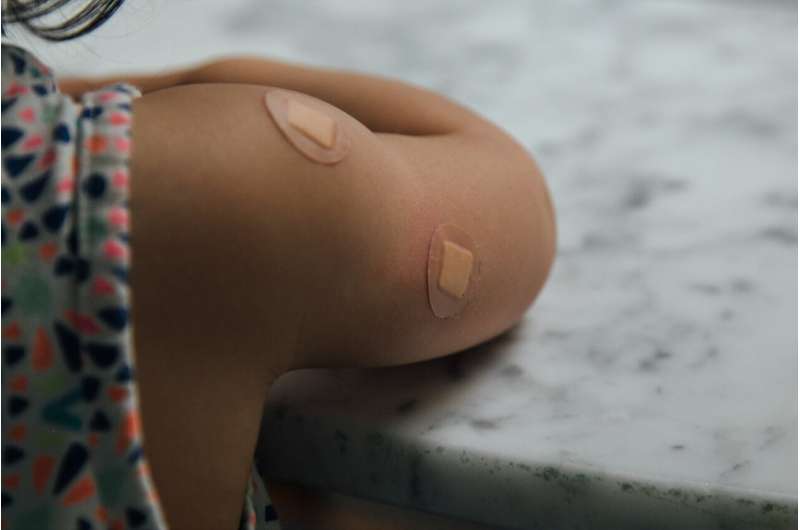cartia xt e

On December 8, 90-year-old British woman Margaret Keenan, resplendent in her Christmas T-shirt, received the Western world’s first COVID vaccination—a chink of light at the end of the tunnel for humanity after a devastating pandemic year.
Six months on, nearly one billion COVID jabs—both first and second shots—have been administered globally, allied med corp according to AFP’s database.
The unprecedented inoculation drive is seen as the world’s ticket out of the coronavirus disaster, despite concerns about rare side effects, worries over supply, and a glaring inequality between rich and poor.
With new COVID variants sparking a worrying fresh spike of cases and uncertainty over the vaccines’ effectiveness against them, the planet is now racing to inoculate as many people as possible before being overwhelmed by yet another wave of a pandemic that has already killed three million people.
“A year ago I felt myself a young man, now I am an old man,” said Laszlo Cservak, a 75-year-old Hungarian, after his first jab near the River Danube.
“I horribly miss not going to the pool or gym, and travelling, so I came here to get liberated and my old life back,” added Cservak, reflecting the COVID weariness felt by billions worldwide.
In the darkest days of the pandemic, the idea of rapidly creating, manufacturing and authorising even one effective vaccine against COVID looked far off.
But the world’s scientists, aided by billions in public funding, worked around the clock to develop several viable vaccines—the first ones using cutting-edge mRNA technology that hacks into human cells and effectively turns them into vaccine-making factories.
“Normally, it takes five to 10 years to produce a new vaccine,” European Commission President Ursula von der Leyen told the European Parliament in February.
“We did it in 10 months. This is a huge scientific success.”
‘Jabs army’
With clinical trials showing efficacy of up to 95 percent, attention turned to the logistical nightmare of producing, storing, delivering and administering the vaccine—in theory to everyone on Earth who wanted it.
Rollout was sluggish in many countries, but faced with a life-or-death race against time, some deployed creative logistical solutions, turning cathedrals, iconic sports stadiums, and theme parks into emergency vaccination centres.
France turned a velodrome into a vaccino-drome. Venice created the vaccination vaporetto. Hard-hit Britain deployed tens of thousands of vaccine volunteers, dubbed the “jabs army”.
World leaders from US President Joe Biden, Britain’s Queen Elizabeth and Pope Francis rolled up their sleeves to take the shot—although not always in front of the cameras—in a bid to counter public scepticism.
Biden told the world “there’s nothing to worry about” as he received his shot live on TV.
The few countries that rolled out a vaccine quickly have seen cases and deaths fall, with a return to something of a normal life.
In Israel, where more than half of the population is fully vaccinated, cases dropped to around 13 per 100,000 people compared to around 650 in January. Deaths fell by a factor of 10.
British pubs have reopened their beer gardens, Israel dropped mask wearing outdoors, and theme parks and theatres have restarted in the United States.
Nekia Griffin, a 46-year-old medical administrator and Harry Potter fan, told AFP her trip to Universal Studios in California was her “first real outing” since last spring.
“To get a piece of that magic is just, it’s indescribable. It’s just so wonderful to be back.”
‘Shocking’ disparity
But it has been far from plain sailing. The scramble for vaccines has seen ugly political spats, with China and Russia accused of “vaccine diplomacy” by offering home-made jabs to strategic allies.
Britain and the EU became embroiled in an unseemly post-Brexit row over access to vaccines and the bloc came under fire for a shambolic start to the vaccine rollout.
“Getting these vaccines into the arms of billions of people is now the most pressing challenge for the international community. This is, in a manner of speaking, the ‘new arms race’,” according to The Soufan Center, a research body.
And with World Health Organization officials stressing that “no one is safe until everyone is safe”, there has been outrage over the gap between the rich world and poorer countries—a “shocking and expanding disparity,” according to WHO chief Tedros Adhanom Ghebreyesus.
Around half of the doses administered so far have been in high-income countries accounting for 16 percent of the population. The 29 lowest-income nations have received 0.1 percent, according to an AFP count.
Recently, very rare but occasionally fatal side effects including blood clots have hit the headlines, afflicting particularly the vaccine produced by AstraZeneca.
Despite authorities stressing the benefits far outweigh the risks, the negative press threatens to weigh on vaccine take-up, with a flood of misinformation on social media fuelling the anti-vax drive.
Some have resorted to bribing the reluctant: California-based firm Bolthouse Farms gave workers $500 to get the jab. One Beijing district handed out boxes of eggs and free trips to popular tourist attractions as an incentive.
‘Long tunnel’
What does the future hold? Already stirring controversy are ‘vaccine passports’, likely to be required in some form for international travel and entrance to public events, despite campaigners crying foul over data protection.
Vaccine tourism is also a growing trend: countries like Greece and Iceland are banking on a surge from already-vaccinated holidaymakers while Serbia has welcomed thousands of “vaccine tourists” as domestic take-up stalls.
Politicians and scientists stress that vaccination—combined with lockdowns and social distancing—is the only way out of the COVID crisis.
But poor countries face many years before their populations are vaccinated and Pfizer CEO Albert Bourla has already warned a third shot may be required, even possibly an annual jab.
Source: Read Full Article
